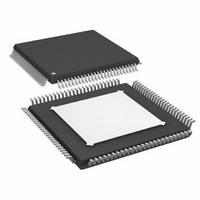AD9273BSVZ-25 Analog Devices Inc, AD9273BSVZ-25 Datasheet - Page 38

AD9273BSVZ-25
Manufacturer Part Number
AD9273BSVZ-25
Description
12Bit 25 MSPS Octal ADC
Manufacturer
Analog Devices Inc
Type
Crosspoint Switchr
Datasheet
1.AD9273BSVZ-25.pdf
(48 pages)
Specifications of AD9273BSVZ-25
Resolution (bits)
12 b
Sampling Rate (per Second)
25M
Data Interface
Serial
Voltage Supply Source
Single Supply
Voltage - Supply
1.7 V ~ 3.6 V
Operating Temperature
-40°C ~ 85°C
Mounting Type
Surface Mount
Package / Case
100-TQFP Exposed Pad, 100-eTQFP, 100-HTQFP, 100-VQFP
Lead Free Status / RoHS Status
Lead free / RoHS Compliant
Available stocks
Company
Part Number
Manufacturer
Quantity
Price
Company:
Part Number:
AD9273BSVZ-25
Manufacturer:
Analog Devices Inc
Quantity:
10 000
AD9273
SERIAL PORT INTERFACE (SPI)
The AD9273 serial port interface allows the user to configure
the signal chain for specific functions or operations through a
structured register space provided inside the chip. This offers
the user added flexibility and customization depending on the
application. Addresses are accessed via the serial port and can
be written to or read from via the port. Memory is organized
into bytes that can be further divided down into fields, as doc-
umented in the Memory Map section. Detailed operational
information can be found in the AN-877 Application Note,
Interfacing to High Speed ADCs via SPI.
There are three pins that define the serial port interface (SPI):
the SCLK, SDIO, and CSB pins. The SCLK (serial clock) is used
to synchronize the read and write data presented to the device.
The SDIO (serial data input/output) is a dual-purpose pin that
allows data to be sent to and read from the device’s internal
memory map registers. The CSB (chip select bar) is an active
low control that enables or disables the read and write cycles
(see Table 15).
Table 15. Serial Port Pins
Pin
SCLK
SDIO
CSB
The falling edge of the CSB in conjunction with the rising edge of
the SCLK determines the start of the framing sequence. During an
instruction phase, a 16-bit instruction is transmitted, followed by
one or more data bytes, which is determined by Bit Field W0 and
Bit Field W1. An example of the serial timing and its definitions
can be found in Figure 70 and Table 16.
During normal operation, CSB is used to signal to the device
that SPI commands are to be received and processed. When
CSB is brought low, the device processes SCLK and SDIO to
process instructions. Normally, CSB remains low until the
communication cycle is complete. However, if connected to a
slow device, CSB can be brought high between bytes, allowing
older microcontrollers enough time to transfer data into shift
registers. CSB can be stalled when transferring one, two, or three
bytes of data. When W0 and W1 are set to 11, the device enters
streaming mode and continues to process data, either reading
or writing, until CSB is taken high to end the communication
cycle. This allows complete memory transfers without having
to provide additional instructtions. Regardless of the mode,
if CSB is taken high in the middle of any byte transfer, the SPI
state machine is reset and the device waits for a new instruction.
Function
Serial clock. The serial shift clock input. SCLK is used to
synchronize serial interface reads and writes.
Serial data input/output. A dual-purpose pin. The typical
role for this pin is as an input or output, depending on
the instruction sent and the relative position in the
timing frame.
Chip select bar (active low). This control gates the read
and write cycles.
Rev. B | Page 38 of 48
In addition to the operation modes, the SPI port can be
configured to operate in different manners. For applications
that do not require a control port, the CSB line can be tied and
held high. This places the remainder of the SPI pins in their
secondary mode, as defined in the SDIO Pin and SCLK Pin
sections. CSB can also be tied low to enable 2-wire mode. When
CSB is tied low, SCLK and SDIO are the only pins required for
communication. Although the device is synchronized during
power-up, caution must be exercised when using this mode to
ensure that the serial port remains synchronized with the CSB
line. When operating in 2-wire mode, it is recommended to use
a 1-, 2-, or 3-byte transfer exclusively. Without an active CSB
line, streaming mode can be entered but not exited.
In addition to word length, the instruction phase determines if
the serial frame is a read or write operation, allowing the serial
port to be used to both program the chip and read the contents
of the on-chip memory. If the instruction is a readback operation,
performing a readback causes the serial data input/output (SDIO)
pin to change direction from an input to an output at the
appropriate point in the serial frame.
Data can be sent in MSB- or LSB-first mode. MSB-first mode
is the default at power-up and can be changed by adjusting the
configuration register. For more information about this and
other features, see the AN-877 Application Note, Interfacing to
High Speed ADCs via SPI.
HARDWARE INTERFACE
The pins described in Table 15 constitute the physical interface
between the user’s programming device and the serial port of
the AD9273. The SCLK and CSB pins function as inputs when
using the SPI interface. The SDIO pin is bidirectional, functioning
as an input during write phases and as an output during readback.
In cases where multiple SDIO pins share a common connection,
care should be taken to ensure that proper V
Figure 69 shows the number of SDIO pins that can be connected
together, assuming the same load as the AD9273, as well as the
resulting V
1.800
1.795
1.790
1.785
1.780
1.775
1.770
1.765
1.760
1.755
1.750
1.745
1.740
1.735
1.730
1.725
1.720
1.715
0
OH
level.
10
NUMBER OF SDIO PINS CONNECTED TOGETHER
20
Figure 69. SDIO Pin Loading
30
40
50
60
70
OH
levels are met.
80
90
100













